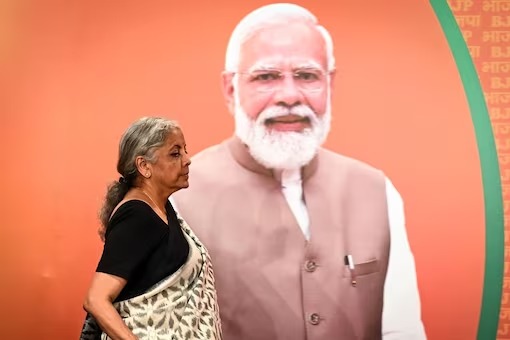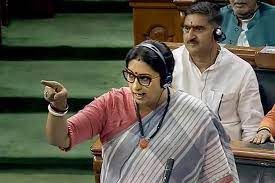Saffron Scoop | The Modinomics of ‘400 Paar’: Five Significant Political Findings from Sitharaman’s 59-page ‘White Paper’
The much-discussed White Paper by Nirmala Sitharaman has 59 pages, 22 graphics, several charts, and numerous data. Drawing a parallel between “them” and “us” was the aim. The White Paper sought to depict the UPA, which was run by Congress, as an economic failure while highlighting Modinomics as a success story. It did this by referencing the IMF and citing foreign research.

However, the BJP cannot just speak about academic concepts like inflation, GDP, and budget deficit as it prepares to take its political message to the streets. It would need significant political breakthroughs to bolster its storyline, which posits that Prime Minister Narendra Modi turned around a failing economy in less than a decade.
THE COMMON MAN’S SUCCESS
The White Paper’s greatest political lesson was how “aam aadmi” fared during the Congress-led UPA administration.
One important criterion for evaluating the two regimes is price stability. According to the White Paper, “the common man bore the brunt of inflation that raged between 2009 and 2014.” Although there is more to be said in terms of numbers when discussing fiscal deficits, the main point is whether or not basic needs were more or less expensive back then.
In simpler terms, during the nine years of the Modi-led NDA administration, fuel prices increased by 90% and diesel prices by 96%, respectively, whereas the prices of both increased under the Congress-led UPA government. Prices increased more sharply during the Congress government, according to the BJP. The BJP apparatus will disseminate the loud and unambiguous message that the ordinary man is better off under Modi than under Manmohan.
2008 Relative to 2014: Loan Loophole
The worldwide financial crisis in India in 2014 is compared to the global recession of 2008. India wasn’t as hard struck by the global financial crisis in 2008, according to a UPA-era finance minister cited in the White Paper. The stimulus program was much larger than the government could afford, and it persisted for a long period as more businesses continued to lay off employees and the unemployment rate rose.
In contrast, the Modi administration let the “massive” 2014 financial crisis to continue. “Bad loans,” which is the term used in the financial industry to describe when a bank extends credit to an organization that is unable to repay it, was one of the explanations given in the White Paper. The article cites a former RBI governor’s written statement to a parliamentary panel in which he acknowledged that “a large number of the bad loans were originated in the period 2006-2008.”
Politically, the government is making innuendos about how loans to companies like former diamond mogul Nirav Modi’s Firestar Diamond and Vijay Mallya’s Kingfisher were made flagrantly without proper thought. Now, both are on the run. About 25% of the loans given to the country’s gem and jewelry industry went to Modi and Mehul Choksi’s firm jointly. Under the Congress administration, all of these were permitted.
IMPACT UPON FORCES
With memories of the surgical strike still raw, the government’s main USP has been “ghar me ghus ke marenge.” Now, however, it wants to take voters back in time to a period when India’s defense readiness suffered due to financial hardship.
The White Paper states that “weak leadership and consistent lack of intent and action resulted in defense under-preparedness.” By 2012, the troops were grappling with a “chronic issue”—a scarcity of ammunition and gear suitable for warfare. The situation was exacerbated by the protracted fighter aircraft procurement procedure. In contrast, the government is acting quickly, as seen by the Rafale contract, with Rafale fighter aircraft now flying in Indian airspace. According to the report, “even the decision to give Indian Army soldiers bulletproof jackets and night vision goggles was kept hanging for years.”
Such reminders at a time when India is experiencing extreme nationalism would significantly stifle the Congress.
“What do I have?” THEN VS. CURRENT
Nothing compares more effectively than numbers in a few specific cases. The comparison of the duration of road construction, the building or delivery of new IIMs or AIIMS, and other tangibles that impact the average person has been a significant political takeaway from Sitharaman’s paper.
Here, the Modi government’s start-up-friendly environment has been a big help in persuading an ambitious India; there are currently 1,17,257 start-ups, up from only 350 back then. The number of National Highways built has more than quadrupled to 54.9 thousand kilometers from 25.7 thousand kilometers during the UPA regime. There were 387 medical schools at that era; now, there are 706. To 1,08,940 seats, medical education has doubled. These are a few quotes that don’t simply represent numbers; they also convey the goals of regular people.
Do you recall SCAM-ISTAN?
Sitharaman exhumed the bodies of fifteen scammers from UPA graves and displayed them for all Members of Parliament to view. She reminded everyone of how widespread corruption marred the 12 days of the 2010 Commonwealth Games, even as India had a successful G20 meeting led by Modi for a whole year.
Sitharaman brought up the Coal Block Allocation scam, which reached the doorstep of then-prime minister Dr. Manmohan Singh; the 2G scam, which resulted in the imprisonment of then-telecom minister D Raja, a Congress ally; the CWG scam, which led to the imprisonment of then-Congress MP Suresh Kalmadi while Sheila Dikshit, the Congress’s then-chief minister of Delhi, was under investigation; and the Aircel Maxis scam, in which the CBI claimed that Karti Chidambaram received bribes for his assistance through his consulting firm Advantage Strategic Consulting Ltd. P Chidambaram, Karti’s father, was a prominent Congressman and the finance minister at the time.
These 15 fraud facts should be enough to remind anybody who may have been swayed by Rahul Gandhi’s current Bharat Jodo Nyay Yatra of the days of the Congress party.
With his “400 par” slogan, PM Modi has already set the goal for the forthcoming Lok Sabha election. The NDA and he might succeed if these five key political insights are taken into consideration.







